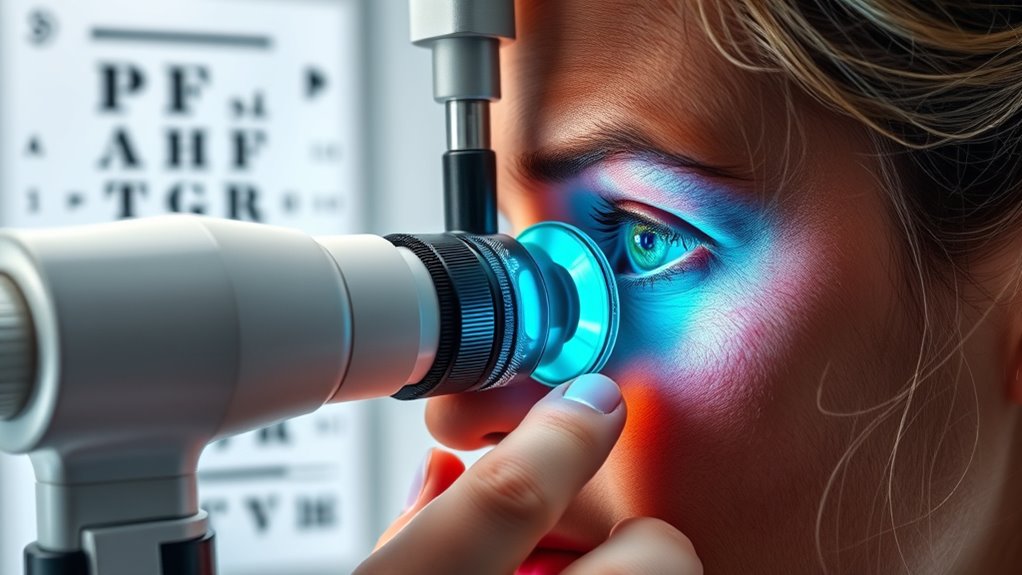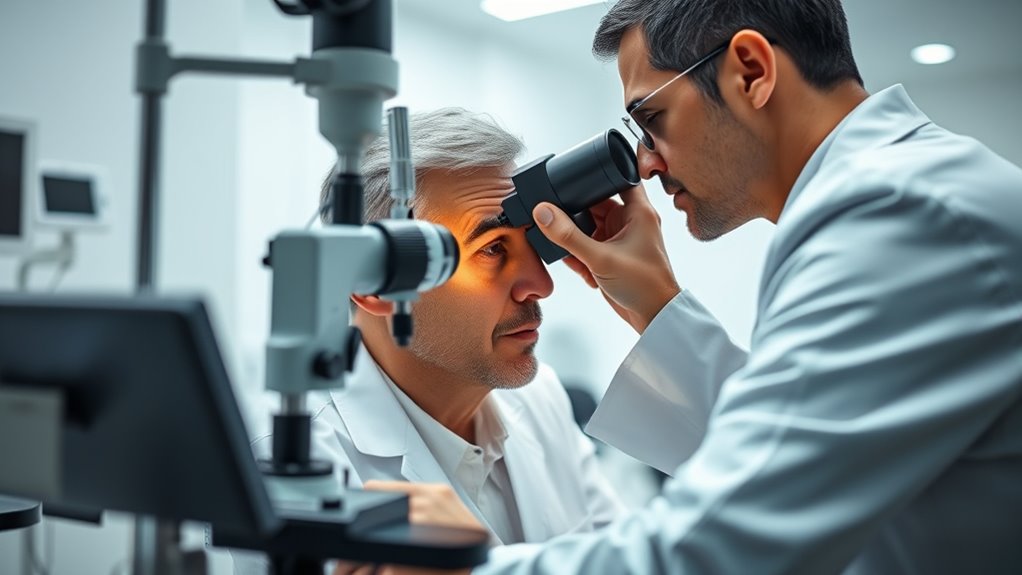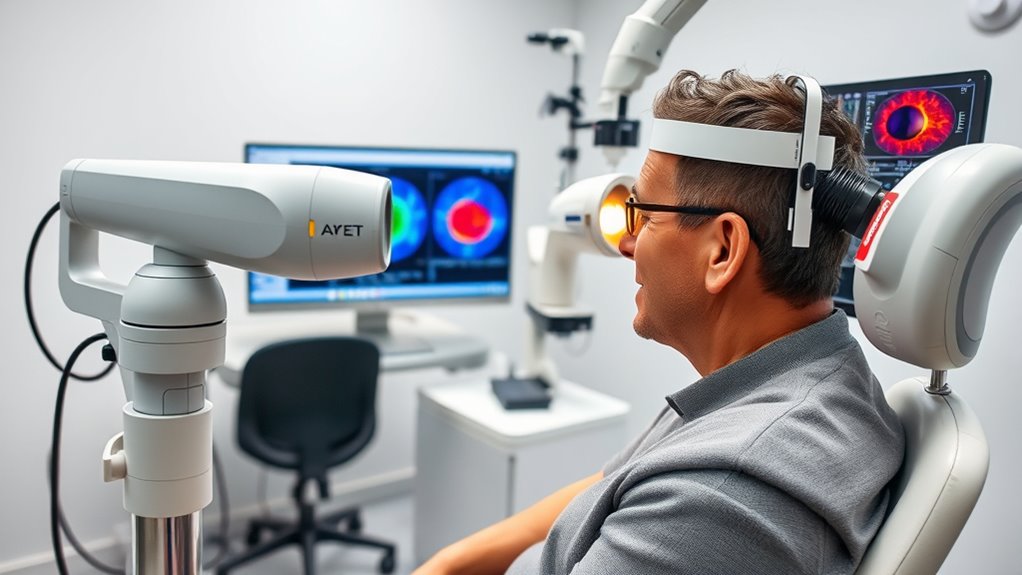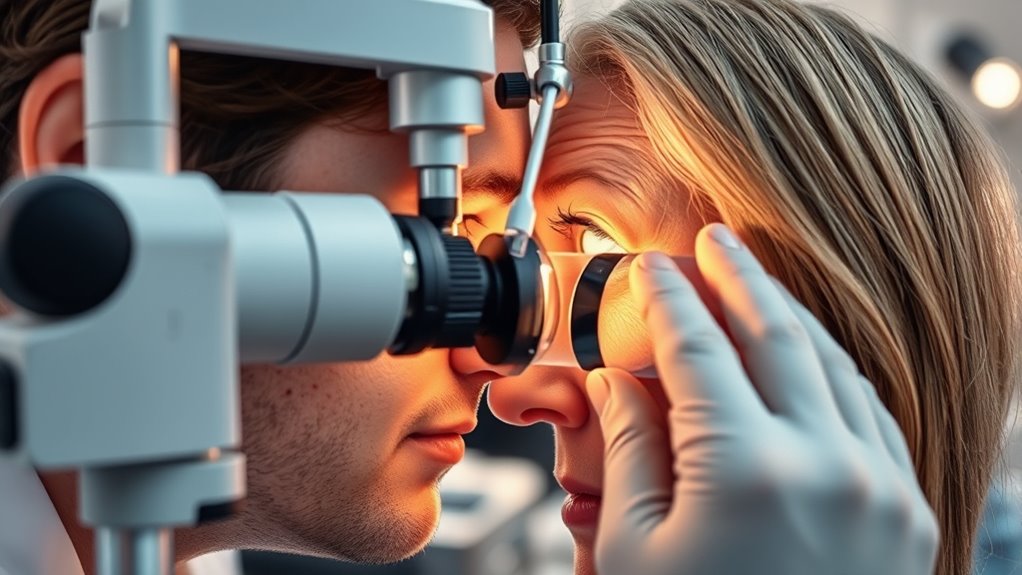Routine eye exams do more than check your vision—they can reveal signs of systemic diseases like diabetes, hypertension, and autoimmune conditions. Eye care specialists look for subtle changes in blood vessels, nerve health, and eye tissues, often catching issues early before symptoms appear elsewhere. Advanced technology and thorough assessments help identify these hidden problems. Keep exploring to learn how regular checkups play a key role in maintaining your overall health and well-being.
Key Takeaways
- Routine eye exams can reveal early signs of systemic diseases like diabetes, hypertension, and autoimmune conditions.
- Eye health assessments include imaging techniques such as OCT and fluorescein angiography to detect vascular and nerve abnormalities.
- Changes like blood vessel narrowing, bleeding, or swelling in the eyes serve as red flags for underlying health issues.
- Regular checkups facilitate early diagnosis, improving management and preventing complications of systemic diseases.
- Advances in AI enhance the accuracy and efficiency of detecting systemic conditions during eye examinations.
The Connection Between Eye Health and Overall Well-Being

Have you ever considered how your eye health reflects your overall well-being? Your eyes aren’t just windows to your vision; they reveal much about your body’s health. Changes in eye appearance, such as redness, dryness, or blurred vision, can signal underlying issues like high blood pressure, diabetes, or inflammation. The blood vessels in your eyes are delicate and can show early signs of systemic diseases before symptoms appear elsewhere. Recognizing the importance of systemic disease detection through eye examinations can lead to early intervention and better health outcomes. Maintaining good eye health through regular exams helps you catch these signs early. When your eyes are healthy, it often indicates that your body is functioning well. Conversely, eye problems can serve as red flags, prompting you to seek medical attention and address health issues before they develop further.
Common Systemic Diseases Detected During Eye Exams

Many systemic diseases can be uncovered during routine eye exams, often before symptoms become apparent elsewhere in the body. For example, diabetes can cause changes in your retina, leading to diabetic retinopathy, which eye care professionals can detect early. High blood pressure may cause narrowing or bleeding in retinal vessels, signaling hypertension. Elevated cholesterol levels can lead to fatty deposits in your eye’s blood vessels, increasing the risk of cardiovascular issues. Multiple sclerosis might show up through optic nerve inflammation, affecting vision. Additionally, autoimmune diseases like lupus can cause inflammation detectable in the eye’s tissues. Detecting these conditions early allows for prompt treatment, potentially preventing serious health complications. Your eye exam isn’t just about vision—it’s a window into your overall health, and understanding systemic disease detection can enhance early diagnosis and management.
Signs and Symptoms Observed by Eye Care Professionals

When you visit your eye care professional, they look for signs like unusual eye color changes, which can signal underlying health issues. They also note vision disturbances and any eye swelling or redness, as these symptoms may indicate systemic conditions. Recognizing these signs early can lead to timely diagnosis and treatment. Additionally, awareness of cultural differences in health perceptions can improve communication and understanding during examinations.
Unusual Eye Color Changes
Unusual changes in eye color can signal underlying health issues that require prompt attention. If your eye color shifts unexpectedly—such as developing a yellowish tint, darkening, or a bluish hue—it might indicate conditions like jaundice, Wilson’s disease, or pigmentary changes linked to systemic illnesses. Eye care professionals observe these color changes during routine exams, as they often reflect broader health concerns. For example, yellowing of the sclera suggests liver problems, while a gray or bluish tint may point to certain genetic or metabolic conditions. Recognizing these systemic health indicators early can lead to timely diagnosis and treatment. Noticing these changes early allows your eye care provider to recommend further testing or specialist consultations. Addressing these signs promptly can lead to early diagnosis and better management of underlying systemic diseases.
Vision Disturbances Noted
Have you ever noticed sudden or persistent changes in your vision during a routine eye exam? These disturbances can include blurred vision, floaters, flashes of light, or difficulty seeing at certain distances. Such symptoms might be subtle at first but can indicate underlying health issues. For example, floaters and flashes could suggest retinal problems, while blurred vision might point to diabetes-related changes or hypertension. When you report these symptoms, your eye care professional evaluates them carefully, as they can be early signs of systemic diseases affecting your eyes and overall health. Recognizing and addressing these disturbances promptly can lead to early diagnosis of conditions like diabetes, high blood pressure, or neurological issues, highlighting the importance of regular eye exams in systemic disease detection.
Eye Swelling or Redness
If you notice persistent eye redness or swelling during an eye exam, it can be a sign that something more is going on beyond simple irritation. Eye swelling or redness can indicate infections, allergies, or underlying systemic conditions like thyroid disease or autoimmune disorders. As an eye care professional, I look for patterns such as unilateral or bilateral redness, associated pain, or changes in vision. Swelling may appear as puffiness or bulging, which can suggest inflammation or increased pressure. Recognizing these signs early helps determine if further testing or referral is needed. Additionally, understanding how contrast ratio impacts the overall image quality can aid in differentiating between benign and serious conditions. Don’t ignore persistent redness or swelling, as they could signal more serious health issues. Early detection during routine exams can lead to timely treatment and better overall health outcomes.
Technology and Techniques Used in Systemic Disease Screening

Advancements in technology have considerably enhanced the ability of eye exams to detect systemic diseases. Modern tools like optical coherence tomography (OCT) provide detailed images of the retina, revealing subtle signs of conditions like diabetes and hypertension. Fluorescein angiography allows you to see blood flow and identify leaks or blockages that signal systemic issues. Automated visual field tests help detect nerve damage related to neurological and vascular diseases. Additionally, digital imaging and analysis software enable quick, accurate assessments of blood vessel health and nerve integrity. These techniques allow eye care professionals to spot early signs of systemic disease, sometimes before symptoms appear elsewhere. Understanding the importance of financial affidavits and other legal documents can also facilitate timely diagnosis and intervention. Using these advanced technologies, your eye exam becomes a crucial screening tool for overall health, facilitating timely diagnosis and intervention.
The Importance of Regular Eye Checkups for Early Diagnosis

Regular eye checkups are vital for catching systemic conditions early before they cause serious health issues. When you schedule routine exams, you help protect your vision and overall well-being. Early detection through eye exams can make all the difference in maintaining your health long-term. Additionally, some systemic diseases, such as diabetes or hypertension, may present signs through eye health that can only be identified during comprehensive examinations systemic disease detection.
Detect Systemic Conditions Early
Since many systemic diseases exhibit early signs that can be detected through the eyes, getting regular eye exams is essential for early diagnosis. During your checkup, your eye care professional examines your retina, blood vessels, and optic nerves, which can reveal signs of conditions like diabetes, hypertension, or autoimmune disorders. Changes such as abnormal blood vessel growth, bleeding, or swelling can indicate underlying health issues before symptoms appear elsewhere. Detecting these signs early allows for prompt intervention, potentially preventing serious complications. Regular eye exams serve as an early warning system, giving you a chance to address systemic health problems before they worsen. Additionally, advances in AI in healthcare are enhancing the ability to identify subtle ocular changes linked to systemic conditions, improving early detection accuracy. By maintaining routine visits, you can protect your overall health and catch conditions in their initial stages.
Maintain Vision Health
Maintaining good vision health relies heavily on consistent eye checkups, which can catch issues early before they affect your sight. Regular exams help identify problems like glaucoma, cataracts, or retinal conditions before symptoms worsen. Early detection allows for prompt treatment, preserving your vision and preventing irreversible damage. Additionally, eye exams can reveal signs of systemic diseases such as diabetes or hypertension, which can impact your overall health. Advances in AI technology continue to improve the accuracy and efficiency of diagnosis during eye examinations. To understand the importance, consider this table:
| Eye Condition | Symptoms | Systemic Connections |
|---|---|---|
| Glaucoma | Tunnel vision, halos | Increased eye pressure |
| Cataracts | Blurred vision, glare | Age-related, metabolic issues |
| Diabetic Retinopathy | Floaters, vision loss | Diabetes management |
| Macular Degeneration | Central vision loss | Age, oxidative stress |
Regular checkups help you maintain clear vision and overall health.
Collaborating With Your Healthcare Providers for Holistic Care

Collaborating with your healthcare providers is crucial for guaranteeing all-encompassing care that addresses both eye health and overall systemic conditions. When you share your eye exam results with your primary care doctor or specialists, it helps create a complete health picture. This teamwork can lead to early detection of issues like diabetes, hypertension, or autoimmune diseases. Effective communication ensures your providers stay informed and coordinate treatment plans. Be proactive in asking questions and reporting new symptoms. Remember, your eye health can reflect broader health concerns, so maintaining open channels with your healthcare team is essential. Incorporating medical symbolism in dreams can also provide insights into your subconscious health state.
Frequently Asked Questions
Can Eye Exams Replace Other Routine Health Screenings?
You might wonder if eye exams can replace other health screenings. While eye exams are essential for detecting eye conditions and some systemic issues, they don’t cover everything like blood pressure, cholesterol, or cancer screenings do. Regular check-ups with your primary care doctor are still necessary for thorough health. Think of eye exams as an important part of your health routine, but not a substitute for other screenings.
How Often Should I Get a Comprehensive Eye Exam?
You might wonder how often you should get a thorough eye exam. The truth is, it depends on your age, health, and risk factors. Generally, adults should have one every 1-2 years, but if you wear glasses or contact lenses, or have eye conditions, your eye doctor may recommend more frequent visits. Regular exams help catch issues early and keep your vision sharp.
Are There Specific Age Groups More at Risk for Systemic Diseases?
Certain age groups face higher risks for systemic diseases. You’re more likely to develop health issues like diabetes, hypertension, or heart disease as you get older, especially after age 40. Young adults can also be at risk if they have a family history or unhealthy lifestyle habits. It’s important for you to stay vigilant, get regular check-ups, and discuss any concerns with your healthcare provider to catch these conditions early.
What Lifestyle Factors Influence Eye Health and Systemic Disease Risk?
Think of your lifestyle choices as the brushstrokes shaping your health portrait. Smoking, poor diet, and lack of exercise act like dark clouds, increasing your risk for eye issues and systemic diseases. Conversely, eating balanced meals, staying active, and avoiding smoking brighten your canvas. These habits influence blood flow, inflammation, and overall resilience, so your daily decisions become the colors that protect your vision and health for years to come.
Do All Systemic Diseases Show Signs During an Eye Exam?
Not all systemic diseases show signs during an eye exam. Some conditions, like certain autoimmune disorders or early diabetes, can be detected through specific eye findings, but others may not affect your eyes noticeably. You need thorough medical testing for a definitive diagnosis. Regular eye exams can help catch some signs early, but they shouldn’t replace regular health checkups. Always consult your healthcare provider for a complete assessment.
Conclusion
Your eyes are like windows to your health, revealing secrets that lie beneath the surface. Regular eye exams act as your personal health detectives, catching systemic diseases before they become full-blown crises. By staying vigilant and working with your healthcare team, you’re charting a course toward a healthier, clearer future. Don’t let unseen threats hide in the shadows—keep your vision vibrant and your health shining bright, one exam at a time.









